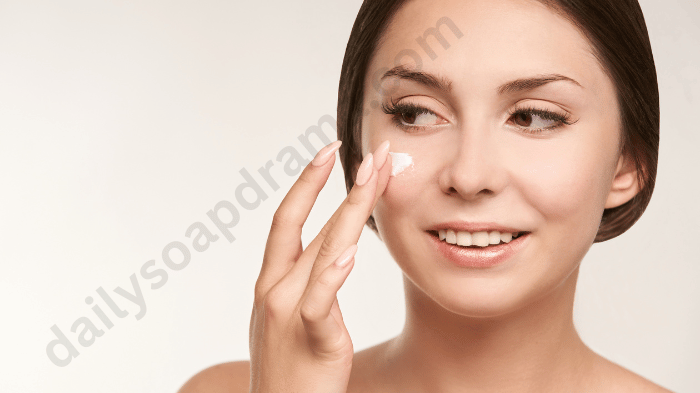When it comes to creating the perfect skincare routine, knowing when to put on eye cream in skincare routine can be a little confusing. It might seem like just another small step, but using it the right way and at the right time can make a big difference. Let me guide you through how I use eye cream in my routine, breaking down when and why to apply it.
Why Do I Need Eye Cream, and What Is It
Eye cream is a hydrating and nourishing treatment created mostly for the skin around my eyes. This region is thinner, more sensitive, and display effects of aging more quickly than other sections of my face. That’s why I chose an eye cream that’s meant to treat puffiness, dark circles, and fine lines.
When to Put on Eye Cream in Skincare Routine

Knowing just when to use my eye cream has helped me obtain greater results. In my experience, the timing might differ reliant on the sort of things I’m utilizing. Eye cream normally goes on after cleaning but before heavier creams. This manner, it can seep correctly into my skin without becoming stopped by other layers.
Read also: My Preppy Skincare and Makeup Routine
Why Does Timing Matter
If I put on my eye cream at the wrong period, it could not work as well. Applying it after a heavy moisturizer, for instance, might make it tougher for the eye cream to soak in and give advantages.
When to Apply Eye Cream Before or After Serum
Another important topic is when to apply eye cream before or after serum? For me, it’s all about stacking the products properly.
The Order of Application
- Cleanser: I start with a light cleanser to wash away the day’s dirt.
- Toner: If I’m using one, I apply it second to prep my skin.
- Serum: This is where I apply my serum, highlight on areas that require more hydration or therapy.
- Eye Cream: Finally, I apply a tiny bit of eye cream around my eyes. It’s vital to utilize a delicate tapping motion so that I don’t irritate the skin.
- Moisturizer: Finally, I seal everything in with a nice moisturizer.
Read also: How Long Can You Use Skincare After Expiration Date
How to Apply Eye Cream
Applying eye cream isn’t simply about putting it on. Here’s how I do it:
Step 1: Prep Your Skin
It's crucial to prep your skin before applying eye cream. First, make sure your hands are clean to avoid spreading bacteria. Next, wash and tone your skin—both in the morning and at night. Last, apply your serums and moisturizers before ending your regimen with eye cream.
Step 2: Choose the Right Amount
Applying eye cream correctly has a lot to do with how much you use. A pea-sized quantity per eye is generally enough to keep the delicate skin around your eye hydrated.
Step 3: Apply It to the Right Spots
Many folks aren't entirely aware where to put eye cream. Some may assume it's designed for your eyelids, for example. Use the following guidelines as a guide:
- Always use your ring finger to apply, as it has a more delicate touch than other fingers.
- Start under the eye and apply it in very little dots toward the inner corner, moving outwards. Make cautious not to come too near to your eyeball.
- Pat—don't massage or drag—the substance onto your skin. The region surrounding your eyes is fragile, so the kinder you can be, the better.
- After applying beneath your eye, work your way up along your orbital bone and under your eyebrow. Continue to tap as you go.
Step 4: Be Consistent
It's crucial to be consistent while applying eye cream. Apply in the morning and at night for optimal effects. You can apply a thinner cream made for daytime in the morning and a thicker eye cream at night, depending on your skin's demands.
Depending on the eye cream you use and how you apply it, you may even be able to decrease the look of wrinkles, undereye drooping and dark circles. Whichever product you select, you're likely to realize its effects with consistent use.
Read also: Order of Skincare Routine: Morning vs Night
Choosing the Right Eye Cream

With so many options out there, how do I choose the right eye cream?
Key Ingredients to Look For
I always check the label for these key ingredients:
- Hyaluronic Acid: Great for hydration.
- Caffeine: Helps with puffiness.
- Peptides: Good for fine lines and skin flexibility.
- Vitamin C: Brightens dark circles.
Morning vs. Night: When to Use Eye Cream Day or Night
I apply my eye cream both in the morning and at night for ideal coverage. Here’s why knowing when to put on eye cream in skincare routine is important: applying it at these times helps me battle puffy and dark circles in the morning while allowing for deep hydration and repairs night.
- Morning: I use eye cream with parts like caffeine to help wake up my eyes, minimize puffiness, and prepare my skin for makeup.
- Night: In the evening, I choose for a more heavy eye cream with soothing components to work overnight, helping to heal and moisturize.
For me, applying eye cream twice a day made an important difference.
Read also: 5 Minute Crafts Beauty Hacks For Face
Ingredients to Consider in an Eye Cream
Here are some of the best ingredients to look for when selecting an eye cream:
Niacinamide
It’s a kind of Vitamin B that can help your skin hold in moisture around the sensitive eye region. Read more about Niacinamide and its many advantages for your skin.
Retinol
This chemical helps accelerate surface skin cell turnover. If you’re thinking about adding retinol to your regimen, then kill two birds with one stone and moisturize the skin around your eyes for 24 hours to notice significant improvements in fine lines and wrinkles with Olay Retinol24 Night Eye Cream. Why a night eye cream? During the night, the skin’s natural capacity to heal itself is more active compared to the day. A night cream is crucial to improving skin repair since the skin is more responsive to active ingredients overnight, and it also helps offset increased moisture loss while you sleep. Learn more about retinol and its numerous advantages.
Peptides
These sequences of amino acids are connected together and function like building blocks for bigger proteins, such as collagen, which is largely responsible for your skin’s firmness. Discover more about Peptides and how you may benefit from them.
Hyaluronic Acid
This is a naturally present sugar in our skin and has an exceptional capacity to store a large amount of water. Hyaluronic Acid helps plump the skin to give it a firmer appearance. Try Olay Eyes Deep Hydrating Eye Gel, which is packed with Hyaluronic Acid, Peptides and Niacinamide for wide-awake eyes and an immediate refresh.
Mistakes When Applying Eye Cream
There are also a few don’ts when it comes to how to apply eye cream:
Don’t apply your eye cream before your moisturiser.
As we already discussed, particular treatments should always occur after the face moisturizing stage.
Don’t let the eye cream come too close to your eye.
Don’t apply it on your eyelids or eyelashes, since it can easily seep into your eye and create discomfort.
Don’t tug at your skin.
If you’re a touch too rough and rub the area instead of softly dabbing, tapping or massaging, your skin might expand. Since the eye region is so delicate, that strain might lead to discomfort or wear and tear on the skin.
Don’t forget that less is more.
Don’t put on more than a pea-sized quantity, since it may also create irritation and you can quickly achieve the opposite result if you go overboard.
Read also: What Skincare Routine Is Best For Oily Skin
My Favorite Eye Creams and Why

Choosing the right eye cream can feel overwhelming, but here are a few I swear by:
- Brightening Eye Cream: Ideal for the morning to decrease puffiness and dark circles.
- Anti-aging Eye Cream: With chemicals like retinol, I take this at night to assist with fine wrinkles.
- Hydrating Eye Gel: Perfect for days when I need more hydration without feeling heavy.
Each of these has a purpose, and I pick them based on what my skin needs that day.
Can You Use Too Much Eye Cream?
Yes, it’s possible to overdo it with eye cream. I’ve discovered that applying too much might actually make my eyes feel more swollen or infected. Sticking to a minimal quantity means my skin absorbs it completely without waste.
Key Takeaways for My Skincare Routine
Here are a few quick tips I’ve learned from my eye cream routine:
- Apply eye cream in the right order: Think about when to put on eye cream in skincare routine, especially in connection to serum.
- Morning and night application: Adjust based on factors for the best results.
- Use the right amount: A pea-sized volume is generally perfect.
- Avoid too-close application: Stick to the orbital bone to avoid difficulty.
Conclusion
I hope this article has helped you understand when to put on eye cream in skincare routine! It’s a simple move that can make an amazing difference. Remember to pick the proper product for your needs and apply it always. With a little love and care, your eyes may seem bright and beautiful. Happy skincare!
FAQ's When To Put On Eye Cream In Skincare Routine
Do I put eye cream on before or after moisturizer?
Generally speaking, you should apply a mild eye cream or serum before moisturizing. To assist seal in moisture, rich, thick eye creams should often be used after moisturizer.
Where does eye cream come in skincare routine?
Applying your toner and serum before your eye cream enables the usually thinner-textured ingredients to seep into the skin first. "This optimizes the efficacy of the powerful and advantageous components in all three products (eye creams, serums, and toners)," adds Robinson.
Do you put vitamin C or eye cream first?
Before applying any other serum to the skin, vitamin C should be used. Eye Cream: At night, I apply DEJ Eye Cream on my eyes. Try using this eye cream method if you want more advantages! For those who are on a tight budget, Vaseline and Aquaphor are excellent nighttime moisturizers.
What are the 7 steps of skincare?
- Cleaner is the first step. Cleaning is typically the first step in your skincare regimen.
- Step 2: Astringent/Toner.
- Step 3: Exfoliators and masks.
- Step 4: Apply a serum.
- Step 5: Apply a moisturizer.
- Step 6: Treatment for the Eyes.
- Step 7: Apply makeup and primer.
Is eye cream basically moisturizer?
In essence, eye creams are just moisturizers that have been carefully designed for use on a particular skin region.








